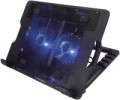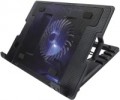Fans
In modern models,
1 or
2 fans are installed at a minimum, and in more advanced models this number can reach
4. It makes no sense to bet anymore, because. the area of the cooling system in this case may be larger than the area of the bottom surface of even the largest laptop. The more fans provided, the more intense the heat removal and the higher the efficiency of the cooling system (ceteris paribus, of course). On the other hand, the noise level increases noticeably, and there are “multi-fan” stands, respectively.
The diameter of the fans also plays an important role. The larger the fan, the more advanced it is considered: a large diameter allows you to create an intense airflow at relatively low speeds, which reduces the noise level compared to smaller options. On the other hand, the large size also affects the cost accordingly.
Max. RPM
The highest rotational speed of the fans provided in the active cooling system of the stand (see above).
Rotation speed is one of the parameters that directly affects efficiency: the faster the fan, the more powerful airflow it creates and the more heat is removed. At the same time, only fans of the same diameter can be directly compared by speed. In addition, high rotation speed increases the noise level; therefore, comparatively slow but large fans are considered more advanced than small and fast ones with the same performance (see "Airflow").
Max. fan airflow
The maximum airflow that a cooling fan can create; measured in CFM — cubic feet per minute.
The higher the CFM number, the more efficient the fan.
Weight
The total weight of the stand. You should pay attention to this parameter first of all if you plan to constantly carry the stand with you, along with a laptop — here light weight can be a noticeable advantage. But if you are looking for an option purely for home use, there is most often no need to pursue low weight: other things being equal, it can be a sign of a small thickness of materials and, as a result, relatively low reliability. In addition, a more massive stand is more stable, it is more difficult to budge or knock over by accidental touch.

